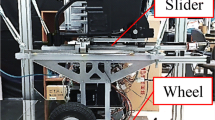Abstract
During transportation by ambulance, a patient is exposed to inertial acceleration when an ambulance decelerates or turns a corner. Such acceleration often gives a patient physical stress such as blood pressure variation or body sway, which causes strong pain, feeling of discomfort or sometimes critical damage for seriously injured persons. To reduce this undesirable effect of the acceleration, the authors developed the actively-controlled bed (ACB) which controls the posture of a stretcher in real time to reduce foot-to-head and lateral acceleration acting on a supine person. This paper describes development of the ACB, including control system design and performance evaluation. The control system is designed by Zakian’s framework, which comprises the principle of matching and the method of inequalities, so that the design specifications on the tracking error and the motor torque are satisfied. From the results of driving experiments and simulation, it is estimated that the ACB can reduce the acceleration acting on a patient by 65% in the foot-to-head direction and by 75% in the lateral direction.
Similar content being viewed by others
References
C. W. Stammers, D. Leyshon. Ambulance Stretcher Suspensions. Proceedings of the Institution of Mechanical Engineers — Part D: Transport Engineering, vol. 199, no. D2, pp. 151–160, 1985.
D. R. Leyshon, C. W. Stammers. The Development and Performance of an Ambulance Stretcher Suspension. Proceedings of the Institution of Mechanical Engineers — Part D: Transport Engineering, vol. 200, no. D4, pp. 249–257, 1986.
J. K. Raine, R. J. Henderson. A Two-degree-of-freedom Ambulance Stretcher Suspension, Part 1: System Overview. Proceedings of the Institution of Mechanical Engineers — Part D: Journal of Automobile Engineering, vol. 212, no. 2, pp. 93–102, 1998.
A. M. Abd-El-Tawwab. Ambulance Stretcher with Active Control Isolator System. Journal of Low Frequency Noises, Vibration and Active Control, vol. 20, no. 4, pp. 217–227, 2001.
K. Sagawa, H. Inooka. Ride Quality Evaluation of an Actively-controlled Stretcher for an Ambulance. Proceedings of the Institution of Mechanical Engineers, Part H: Journal of Engineering in Medicine, vol. 216, no. 4, pp. 247–256, 2002.
T. Kawashima. Development of Active Controlled Pendulum Type Bed for Ambulance: Prevention of the Patient Sliding on the Bed. In Proceedings of 1st Asian Conference on Multibody Dynamics, The Japan Society of Mechanical Engineers, Japan, pp. 446–453, 2002.
T. Ono, H. Inooka. An Actively-controlled Bed Reducing the Effect of Centrifugal Force on Patients. In Proceedings of SICE Annual Conference, The Society of Instrument and Control Engineers, Japan, vol. 3, pp. 2720–2725, 2003.
V. Zakian. Critical Systems and Tolerable Inputs. International Journal of Control, vol. 49, no. 4, pp. 1285–1289, 1989.
V. Zakian. Well Matched Systems. IMA Journal of Mathematical Control & Information, vol. 8, no. 1, pp. 29–38, 1991.
V. Zakian. Perspectives on the Principle of Matching and the Method of Inequalities. International Journal of Control, vol. 65, no. 1, pp. 147–175, 1996.
V. Zakian (ed.). Control Systems Design: A New Framework, Springer-Verlag, London, 2005.
V. Zakian. A Performance Criterion. International Journal of Control, vol. 43, no. 3, pp. 921–931, 1986.
Author information
Authors and Affiliations
Corresponding author
Additional information
Takahiko Ono received the B. Eng. degree in mechanical engineering from Tohoku University, Japan, in 1994, and the M. Info. Sc. degree and the Ph.D. degree in information sciences from Tohoku University, Japan, in 1996 and 1999, respectively. He was a research associate at Tohoku University from 1999 to 2004. Currently, he is a lecturer at Graduate School of Information Sciences, Hiroshima City University, Japan.
His research interests include robust control, critical control, optimal filtering theory, and analysis and modelling of human reactions to acceleration in vehicle transportation.
Hikaru Inooka received the Ph.D. degree in mechanical engineering from Tohoku University, Japan, in 1969. He joined Tohoku University as a lecturer from 1969 to 1971 and an associate professor from 1971 to 1984. He was a visiting scholar at University of Manchester Institute of Science and Technology (UMIST), Manchester, UK, from 1980 to 1981. He was a professor from 1984 to 2004, and now is a professor emeritus at Tohoku University. In 2007, he initiated Research House LOGOS.
His research interests include the measurement of human behavior in daily life and ride comfort of passenger cars and ambulances.
Rights and permissions
About this article
Cite this article
Ono, T., Inooka, H. Actively-controlled beds for ambulances. Int. J. Autom. Comput. 6, 1–6 (2009). https://doi.org/10.1007/s11633-009-0001-2
Received:
Revised:
Published:
Issue Date:
DOI: https://doi.org/10.1007/s11633-009-0001-2




